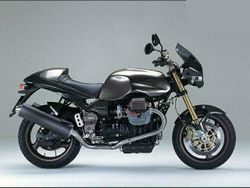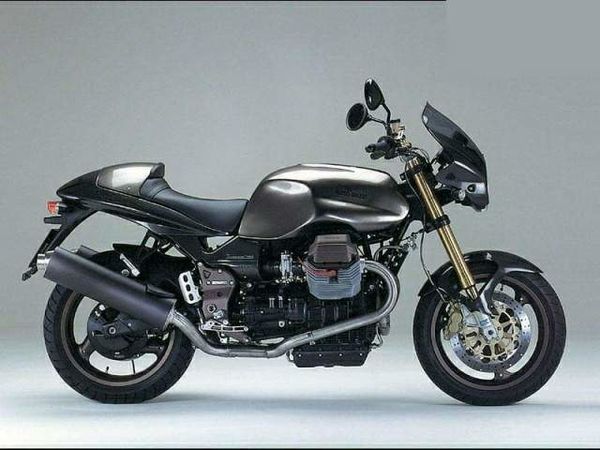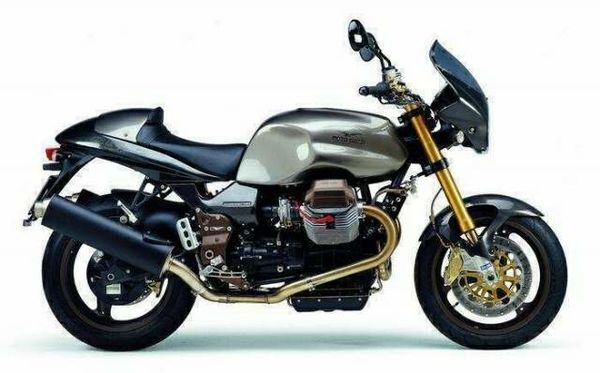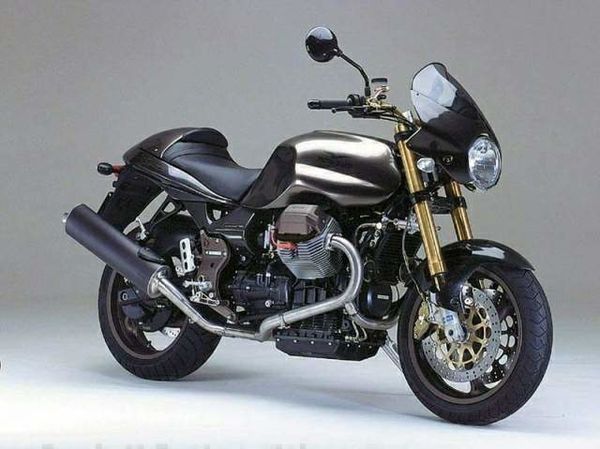Moto Guzzi V11 Café sport
 |
|
| Moto Guzzi V11 Café sport | |
| Manufacturer | |
|---|---|
| Production | 2002 - 03 |
| Engine | Four stroke, 90° V twin, longitudinally mounted, OHV, 4 valve per cylinder. |
| Compression ratio | 9.8:1 |
| Ignition | Magneti Marelli IAW electronic digital |
| Transmission | 5 Speed |
| Suspension | Front: 43mm Öhlins upside-down forks, adjustable compression Rear: Cantilever swingarm, Sachs Boge mono shock, adjustable compression and rebound damping |
| Brakes | Front: 2x 320mm discs 4 piston calipers Rear: Single 282mm disc 2 piston caliper |
| Front Tire | 120/70-17 |
| Rear Tire | 170/60-17 |
| Wheelbase | 1490 mm / 58.7 in |
| Seat Height | 800 mm / 31.5 in |
| Weight | 226.0 kg / 498.2 lbs (dry), |
| Fuel Capacity | 20.7 Liters / 5.4 US gal |
| Manuals | Service Manual |
Engine[edit | edit source]
The engine was a Air cooled cooled Four stroke, 90° V twin, longitudinally mounted, OHV, 4 valve per cylinder.. The engine featured a 9.8:1 compression ratio.
Chassis[edit | edit source]
It came with a 120/70-17 front tire and a 170/60-17 rear tire. Stopping was achieved via 2x 320mm discs 4 piston calipers in the front and a Single 282mm disc 2 piston caliper in the rear. The front suspension was a 43mm Öhlins upside-down forks, adjustable compression while the rear was equipped with a Cantilever swingarm, Sachs Boge mono shock, adjustable compression and rebound damping. The V11 Café sport was fitted with a 20.7 Liters / 5.4 US gal fuel tank. The bike weighed just 226.0 kg / 498.2 lbs. The wheelbase was 1490 mm / 58.7 in long.
Photos[edit | edit source]
Overview[edit | edit source]
Moto Guzzi V 11 Café sport
Here's the thing; Moto Guzzis are really
classic British bikes in disguise.
I
mean think about it for a minute; long legged, loping power from an old
fashioned, but much enlarged engine design, a certain level of eccentric
engineering and unique handling traits, plus a reputation for less than
perfect reliability and finish. It all reminds you of Norton, Triumph,
Vincent etc But Guzzi are overcoming most of the problems of the past, which
afflicted British bikes too, once saw the Italian marque dubbed `tractors'
and sent Moto Guzzi sliding into bankruptcy. All that changed when Aprilia
took over the company a few years back. The most obvious change that you
notice as soon as you ride away on the Café Sport is in the engine
department. The 1100cc V-twin goes well, damn well, for something which has
its design roots in the 1940s.
This is still a motor which features
pushrods, but the electronic engine management and Marelli fuel injection
are now spot-on, giving the engine a beautiful spread of power from
2,000rpm-6,000rpm. It growls menacingly at traffic lights, shaking the bike
gently, but accelerates without a trace of hesitation each and every time
you gas it up. I was impressed at how fast the bike could surge forward, in
any of its six gears. For blatting around the B roads of Shropshire, the
Café Sport was top fun, even in the wild 'n' windy March weather and I had
no trouble despatching drivers of `fast' cars to my mirrors - the Guzzi is
fast enough for the average country road.
The nose fairing offers little wind
protection - not that even a howling gale could move the bike sideways a
great deal - so the bike, and the rider, tends run out of serious steam at
about 110-120mph. Beyond this, I think the average Suzuki SV1000 owner, or
Aprilia Tuono rider, would be shooting off over the horizon, assuming they
wanted to risk jail in Blair's new Puritan Britain, where fun is soon to be
outlawed altogether.
The Guzzi is still a more laid-back kind of
machine than the average big twin. A fundamentally different two wheeled
experience.
It has a roominess that Buell owners can
only dream about for example. The handlebars are high, set wide and the
saddle offers plenty of space. The gearbox is still notchy, but you soon
adapt and find a certain pleasure is mastering this one hangover quirk from
Guzzi's dark days. As well as a smooth, steady delivery of torquey power,
the Guzzi's injection set-up also proved quite miserly with the unleaded
too, returning an average of 47mpg on a mix of motorways and twisty B roads.
I find it hard to believe that the gas tank is 20 Liters big. The warning light flickered on anywhere after 100 miles and it took only eight or nine quid's worth of fuel to fill it up again. Maybe I should have ridden onwards with the warning light on, but with an injected bike, you never want to run out of gas in case it fouls up the system up do you? Another thing which makes the bike addictive is the engine noise. The Guzzi barks and snarls through its pipes like some old school rock band, determined to ignore all warnings of hearing damage or respecting the neighbours. I like that. Motorbikes used to always have a unique sound and it's great that the Italians are keen on keeping this tradition alive. This stuff matters.
THE BESPOKE HOOLIGAN OPTION
When you look at the kit on the Café Sport, you see where the high asking
price is justified, to an extent. Beautiful gold anodised Öhlins forks, a
neat steering damper, carbon fibre bits `n' pieces, gold callipers, Brembo
disc brakes and an exhaust system made from proper metal, not some
soft-as-butter recycled Coke cans. The Café Sport looks very durable,
solidly made and likely to last a long time.
This is one of the things I rate as a
`British' tradition about the bike.
Once, men bought big motorbikes like
Vincents, Brough-Superiors, or Norton Commandos intending to rack up a
healthy mileage over a span of several years. They were prepared to do some
routine jobs on the bikes to keep them going, but they expected basic
components to last for decades before rusting away. It's great to see Guzzi
transformed into a brand which is arguably better built than some Honda and
BMW models and yes, I never thought I would live to write that sentence.
But there's still no denying that owning a
V11 Guzzi Café Sport is still a more challenging proposition than snapping
up a Honda CB1300, Suzuki Bandit, or a BMW R1100. It isn't as wild a beast
to tame as the Aprilia Tuono, but the Guzzi does need a fair degree of
muscling to make it corner successfully, especially on bumpy roads. This is
not a perfectly balanced, do-it-all motorcycle, it demands some ability,
some serious input from its rider.
The brakes are excellent, but the sheer mass
( the Café Sport weighs 226 kilos dry ) makes stopping quickly a challenge,
especially on wet roads. The Guzzis also carry their weight relatively high,
which presents another set of handling problems which the rider has to learn
to conquer, or at least ride around to an extent. You still need to
carefully plan exactly where you're going on the Guzzi, choose a line, then
stick to it - this is not, and never will be, a nimble trackday tool.
That alone restricts its market in today's
leisure biking world, because to be blunt, there are few riders about who
are willing to adapt their riding style to something which occasionally
shakes its head, or needs years of skill to brake late into an off-camber
bend on a bumpy B road. Easy to ride bikes like the CBR600 have made too
many of us lazy riders, to a degree, almost unable to cope with a machine
which needs a set of skills to tame.
But if you're looking for a retro motorbike
which is unique, distinctive and sounds like Thor's hammer then look no
further. The Café Sport is an acquired taste, but a powerfully addictive one
in the long run.
One day, it will also be a classic bike.
It's resale value will drop to a certain level, then fall no further, so
long as you look after it. Those traits will appeal to many older riders who
have lost thousands of pounds buying discounted machines which are worth
half the new price in is a little as two years. For a bit of an oddball, the
Guzzi Café Sport makes a great deal of sense in other ways.
Source insidebikes.com
| Make Model | Moto Guzzi V 11 Café sport |
|---|---|
| Year | 2002 - 03 |
| Engine Type | Four stroke, 90° V twin, longitudinally mounted, OHV, 4 valve per cylinder. |
| Displacement | 1064 cc / 64.9 cu-in |
| Bore X Stroke | 92 x 80 mm |
| Cooling System | Air cooled |
| Compression | 9.8:1 |
| Induction | Magneti Marelli IAW Multipoint phased sequential fuel injection |
| Ignition | Magneti Marelli IAW electronic digital |
| Starting | Electric |
| Max Power | 91 hp / 66.3 kW @ 7800 rpm |
| Max Torque | 94 Nm / 69.3 lb-ft @ 6000 rpm |
| Transmission | 5 Speed |
| Final Drive | Shaft |
| Front Suspension | 43mm Öhlins upside-down forks, adjustable compression |
| Front Wheel Travel | 120 mm / 4.7 in |
| Rear Suspension | Cantilever swingarm, Sachs Boge mono shock, adjustable compression and rebound damping |
| Rear Wheel Travel | 128 mm / 5.0 in |
| Front Brakes | 2x 320mm discs 4 piston calipers |
| Rear Brakes | Single 282mm disc 2 piston caliper |
| Front Tire | 120/70-17 |
| Rear Tire | 170/60-17 |
| Trail | 103 mm / 4.1 in |
| Dimensions | Length 2150 mm / 84.6 in Width 810 mm / 31.9 in |
| Wheelbase | 1490 mm / 58.7 in |
| Seat Height | 800 mm / 31.5 in |
| Ground Clearance | 178 mm / 7.0 in |
| Dry Weight | 226.0 kg / 498.2 lbs |
| Fuel Capacity | 20.7 Liters / 5.4 US gal |


